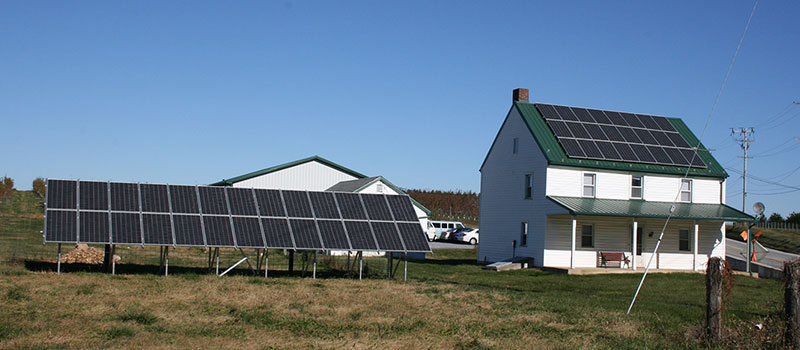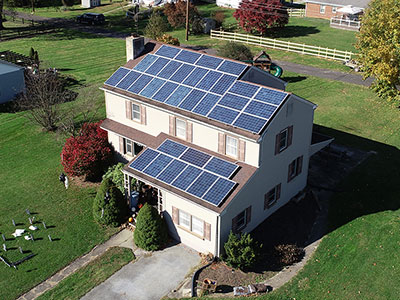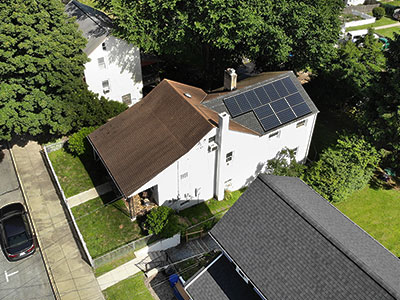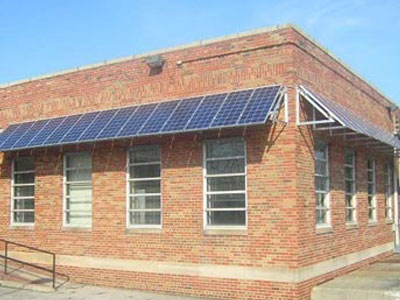Accessory solar energy systems are usually roof mounted but can include free-standing ground mounted solar arrays.
Principal solar energy systems, often referred to as grid-scale solar or utility-scale solar, generate electricity that is added to the electric power grid. See the Chester County Solar Power Guide for more information on principal solar energy systems.
Allowing solar energy systems in municipalities supports increased use of clean renewable energy.
How it Works
Carefully crafted regulations for solar energy systems can encourage the use and growth of solar energy. Without appropriate solar energy system zoning in place, municipalities potentially leave themselves and solar energy system owners vulnerable to misinterpretations on what is allowed and may make it unnecessarily difficult and costly to install these systems.
Zoning regulations can address two types of solar energy systems: accessory solar energy systems and principal solar energy systems. When solar power is used to meet the needs of a home, a business, or an institution, it is considered an accessory use to the primary use on a property. Accessory solar energy systems, such as roof-mounted or free-standing ground mounted solar arrays, are typically regulated and permitted like other types of home and building improvements. When solar facilities are the principal use on a property, they are often referred to as grid-scale solar or utility-scale solar, with the primary purpose of the facility being to generate electricity that is added to the electric power grid. These power generator land uses have a different footprint and impact than accessory solar energy systems. They are much larger in scale, require significantly more land, and export electricity from the property. Because of the amount of land used for these facilities, municipalities should carefully plan where they can go in the community and how they are sited on specific properties.
This eTool is focused on zoning for accessory solar energy systems. For more information on planning for and regulating principal solar energy systems (i.e., grid-scale solar) see the Chester County Solar Power Guide.
Benefits
Provide Predictability
Clearly written solar energy system regulations establish a process for review and approval that creates predictable results for solar power system users, installers, municipal code officials, and the community at large.
Reduce Costs
Comprehensive solar energy system regulations can minimize the time and expense needed to obtain municipal approval.
Protect the Environment
Allowing solar energy system uses in municipalities supports increased use of clean renewable energy.
Support the Local Solar Market
Supportive zoning regulations encourage the use of solar energy systems, enhancing the clean energy economy and growing related jobs.
Allowing accessory use solar energy systems, including ones installed on parking canopies, by-right in major zoning districts is a significant way to streamline the process of approving these systems.
Get Started
Standards in zoning ordinances are based on the vision and goals identified in a community’s planning documents. To establish zoning standards for solar energy systems, municipalities should integrate renewable energy policies into their comprehensive plan goals and other long range planning documents. Comprehensive plans should address this issue, both from a land use perspective and from a community facilities/utilities perspective. The PA Municipalities Planning Code indicates a comprehensive plan should promote energy conservation and effective utilization of renewable energy sources. In addition, local municipalities should consider creating sustainability, climate action, greenhouse gas reduction, or energy transition plans to support the use of solar power and other clean energy systems.
Communities should have clearly written zoning regulations to facilitate the use of solar energy in a manner that minimizes the potential for nuisances. For accessory use solar energy systems, allowing them by-right in most zoning districts is a significant way to streamline the process of approving these systems. Municipalities can establish development standards that by-right accessory use energy systems must meet to avoid the need for additional permits or approval by special exception or conditional use.
Municipalities have options for regulating the use and installation of accessory use solar energy systems. A best practice is to develop supplemental regulations specific to solar energy systems that balance solar energy system equipment siting needs with the need for compatibility with adjacent land uses. These supplemental regulations can specify height exemptions, set structural setbacks from lot lines, and limit lot coverage if appropriate. Supplemental regulations for accessory solar energy systems can encourage installations that are cost effective, safe, and compatible with existing land use goals, including goals for historic preservation areas.
Keep in mind principal use solar energy systems have different issues and need to be addressed in a different manner. For more information on planning for and regulating principal solar energy systems (i.e., grid-scale solar) see the Chester County Solar Power Guide.
Definition sections should not address concerns about system siting, which is better addressed through appropriate supplemental use, setback, or height restrictions.
Solar equipment on a historic building should be installed in secondary locations, like these awnings shown on the side and rear of a historic post office, so they are out of view from the public right-of-way.
Photo from Illustrated Guidelines on Sustainability for Rehabilitating Historic Buildings, National Park Service, U.S. Department of the Interior, Technical Preservation Services.
Considerations
Context
Issues of solar access and nuisances associated with solar energy systems are in most instances less important in rural areas where there is low density. In rural areas, aesthetic issues or solar access issues might come into play in conservation or cluster subdivision areas, where homes may be closer together or protected trees might limit solar access. Ordinances can require or recommend that project owners obtain solar access easements from abutting properties.
Definitions
Clearly written and comprehensive definitions for types of solar energy systems help avoid potential misinterpretations. Definitions should include terms for system types, such as roof-mounted, ground-mounted, and building-integrated.
Setback Requirements
Setback distances may be required for specific types of solar energy systems. For ground-mounted solar energy systems, setback requirements can help alleviate aesthetic and safety concerns, yet overly restrictive setback requirements can limit the available space in which a solar array can be sited. Setback requirements for roof-mounted systems can ensure building code compliant pathways exist for access along roof edges and ridge lines for first responders in case of a fire or for maintenance crews in the case of system repair.
Height Requirements
Building height exceptions are recommended to accommodate solar energy system equipment. Typically, solar energy systems are given the equivalent height exception standards as building-mounted mechanical devices or equipment. For ground or pole mounted solar energy systems, communities may want to consider a height exemption, especially if the accessory structure height limit is less than 15 feet. In communities with both sloped and flat roof types, including separate regulations by roof type may be appropriate.
Stormwater Management
Per state guidance, Chester County's model stormwater management ordinance specifies that the horizontal projection of solar panels is not counted as impervious surface for stormwater management purposes if the panels are located above a pervious surface. Ordinance language for solar energy systems should mirror language in the municipality's stormwater management ordinance or refer to the stormwater management ordinance.
Trees
Removing trees to install solar technology is generally not recommended. However, there may be legitimate arguments for and against removing trees to accommodate solar panels. Municipalities are encouraged to consider if this is an issue warranting local regulation. If there are existing tree protection standards in municipal ordinances, for example, the municipality can consider if solar panels should be given any special consideration and amend the ordinance accordingly.
Historic Districts and Properties
In historic districts and on historic properties, new solar panels can be perceived as intrusive and its modern technological design may not be in character with the district or property. The following are examples of guidelines that could be considered when solar panels are being added to a historic property:
- Locate roof-mounted panels on additions at the rear of buildings, on roof slopes that are not prominent, on flat roofs screened from view with a parapet, at the rear of properties, or in a similar unobtrusive location.
- Use solar roof tiles that generate solar power but mimic conventional roofs.
- Screen ground-mounted systems and do not permit in front yards.
Refer to the Secretary of the Interior's Standards for Rehabilitation (see link under References) for implementing solar energy systems on historic properties.
Regulatory Impediments
One of the most common barriers to solar energy in developing areas are restrictive covenants in new subdivisions or in homeowner association documents. While these restrictions are intended to maintain the appearance of homes and property values, they can discourage the use of solar energy systems. Design standards in zoning ordinances can protect against poor design of accessory use solar energy systems and prevent a developer or homeowner's association from creating unwarranted restrictions on renewable energy sources. Other potential impediments to avoid for accessory use solar energy systems are arbitrary restrictions on electricity production and overly strict requirements for glare studies, landscaping, and screening.
Incentives
Municipalities can use incentives to encourage private investment in solar energy systems. Example incentives include density bonuses and parking requirement offsets. As with any incentive, an important element of creating the incentive is to engage planning or economic development staff in the creation of the incentive, so that staff can assist the developer in taking advantage of the provisions.
Principal Solar Energy Systems
Principal solar energy systems are power generator land uses with a different footprint and impact than accessory solar energy systems. They are much larger in scale, consume significantly more land, and export electricity from the property. Because of the amount of land used for these facilities, municipalities should carefully plan where they can go in the community and how they are sited on specific properties. More information on planning and zoning for principal solar energy systems is available in the Chester County Solar Power Guide.
Examples
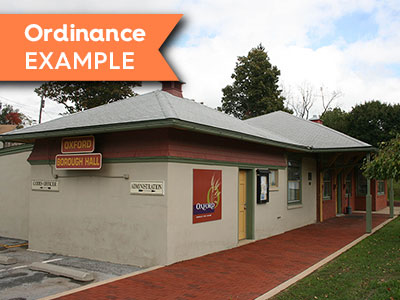
Oxford Borough provides standards for the use of solar energy equipment as accessory uses to minimize negative impacts on residents and properties, while promoting the use of alternative energy sources, where appropriate.
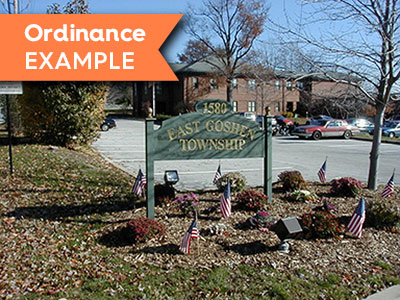
East Goshen Township has a single permit application process for accessory solar energy systems.
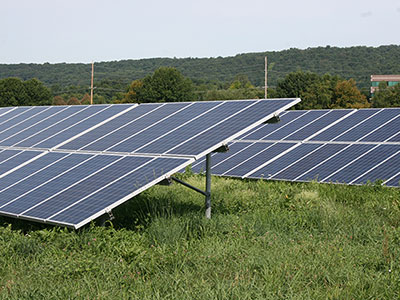
Model Ordinances
The Chester County Planning Commission Clean and Sustainable Energy webpage includes several solar model ordinances and information on other alternative energy sources.


